Momentum Under Pressure: What Drove S&P 500 Stock Returns During the 2025 Market Dislocation?
At Nimbus Financial Lab, we have been actively testing algorithms based on momentum strategies for some time. During this testing phase, following the election of Donald Trump as U.S. President, a series of domestic and international developments—most notably the announcement of new tariff policies—introduced considerable uncertainty into the market. These events, along with other global shifts, triggered heightened volatility starting in mid-February.
In this environment, we observed notable deviations in the performance of our momentum-based algorithms compared to more stable periods. While academic literature has extensively documented the predictive power of past performance in explaining stock returns, there remains a relative scarcity of research that focuses specifically on return behavior during turbulent or transitional market conditions—particularly in the immediate aftermath of political and macroeconomic shocks.
Motivated by this gap, we decided to conduct a focused analysis of the February 19 to June 12, 2025 period. While our findings broadly align with recent studies on momentum crashes and mean reversion dynamics, they also suggest the need for a more nuanced approach that integrates firm fundamentals and market context.
This report marks the first step in a broader effort. In the coming months, we intend to expand this analysis to cover additional historical downturns and to incorporate a deeper balance sheet–based perspective. By doing so, we aim to better understand how stock performance differentiates during periods of market stress, and how predictive models can be improved for greater resilience across economic regimes.

